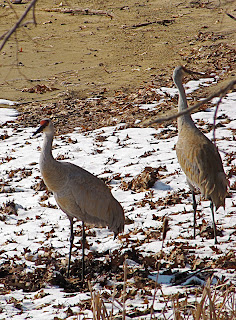Late February by Ted Kooser : The Poetry Foundation
The wind was cold off Kent Lake yesterday, but
the sky was pure blue, and the water looked cold and solid, but pure. It was
one of those rare days when I feel beauty in a northern winter.
I had the thought too that I’ve never had an unpleasant
experience at Kensington Metropark. I always feel as if I’ve entered rural America rather than the nearly five thousand planned acres where we suburbanites can forget weekday worries
and feel in touch with nature for awhile.
I was excited to happen upon a pair of Sandhill Cranes, the first I’ve been able to photograph, though these shots aren’t as good as my real-life excitement was.
I was excited to happen upon a pair of Sandhill Cranes, the first I’ve been able to photograph, though these shots aren’t as good as my real-life excitement was.

As I was returning to the car, I met a chatty sixty-ish couple with two dogs, one nasty, snarling Samoyan and one friendly mutt, black and tan, medium-sized. They told me I’d missed a bald eagle in the area where I found the cranes; they were not at all impressed by my cranes. The wife seemed to be saying, “Well, of course. Who hasn’t seen Sandhill Cranes here? Are you also titillated by sparrows?”
That doesn’t match the dark turn toward the end of Ted
Kooser’s “Late February,” but maybe there’s a loose connection when the subject
is the beauty and doom of northern winters.
Late February by Ted Kooser : The Poetry Foundation
I’m not sure I’d break Kooser's last five words into two lines,
as he does, and I cannot see those children bending “to the work/of building dams,” but
every other image cracks with truth and, by the way, accuracy. They are amplified by Kooser’s
typically soft-spoken understatement, restraint, and dignity, which make him trustworthy,
reliable, not some histrionic showman. Snow patches like discarded laundry, children
who look like old men, “blue TVs/flashing . . . in picture windows” are remarkable in the way they blend clarity, vividness and calm. I also admire the subtlety of cornfields that are being staked for
suburban development, another kind of winter, one more signal of the decline of farming.
The revealing of the farmer and the likening of that to a
tulip are bold turns. At first I thought, “Whoa. Easy there, Mr. Kooser. Let's not leap to a TV crime show.” But after a couple of readings, I've warmed to that
concluding simile—it’s sudden, dramatic, vital, the opposite of
the ennui in the poem’s first two-thirds or so. Isn’t that precisely the way
tulips and spring’s rebirth begin? If discovering a months-dead farmer is
dramatic, so is the new life that replaces him. For such a laconic
midwestern poem, this is startling stuff—just as it needs to be if we’re to
receive, and believe, Ted Kooser’s news about life, death, and high drama, even in Nebraska.



By the way, my fairy godmother or muse or Some-Being must
have been looking out for me: I
had no intention of pairing Nebraskan Ted Kooser with Sandhill Cranes, but
there it is—the Platte River Valley is a renowned layover for cranes in migration.
“For the cranes, the Platte River
Valley is the most important stopover on this migration. The river provides the
perfect spot to rest, and the nearby farmlands and wet meadows offer an abundance
of food. Without the energy gained along the Platte, cranes might arrive at
their breeding grounds in a weakened condition—where food may be limited until
the spring growing season begins.”
For more on cranes: http://www.rowesanctuary.org/crane%20facts.htm






















